THE WORLD BIRDS - An Online Bird Book
GALLIFORMES
New World quail
Order Galliformes Family Odontophoridae
GALLIFORMES
Galliformes are heavy-bodied ground-feeding domestic or game birds. Most are plump-bodied with thick necks and moderately long legs, and have rounded and rather short wings. They do not fly well if at all, but walk and run instead for transportation. These birds vary greatly in size from 12-120 cm. Many adult males have one to several sharp horny spurs on the back of each leg, which they use for fighting. They can be found worldwide and in a variety of habitats, including forests, deserts, and meadows. Male courtship behavior includes elaborate visual displays of plumage. Gallinaceous birds feed on a variety of plant and animal material, which may include fruits, seeds, leaves, shoots, flowers, tubers, roots, insects, snails, worms, lizards, snakes, small rodents, and eggs.
Family Phasianidae: francolin, grouse, partridge, pheasant, Old World quail.
Family Cracidae: chachalac, curassow, guan.
Family Phasianidae: francolin, grouse, partridge, pheasant, Old World quail.
Family Cracidae: chachalac, curassow, guan.
New World quail
Order Galliformes Family Odontophoridae
New World quails are generally short winged, necked and tailed. The bills are short, slightly curved and serrated. The legs are short and powerful, and lack the spurs of many Old World galliforms. Although they are capable of short bursts of strong flight, New World quails prefer to walk, and will run from danger, taking off explosively only as a last resort. Plumage varies from dull to spectacular, and many species have ornamental crests or plumes on the head. There is moderate sexual dichromisim in plumage, with males having brighter plumage. They are shy diurnal birds and generally forage on the ground, but roost in trees or bushes. They are generalists with regards to their diet, taking insects, seeds, vegetation and tubers.
New World quails and Old World quails are not closely related, but because of convergent evolution they have similar appearances and behavior.

California Quail Image by Michael_Klotz
Genus Callipepla
The quails of genus Callipepla are called crested quails because each of the 4 species has a crest. And these are not normal crests, they are thin and eye-catching. They are very social - during the nonbreeding season they form groups that are called coveys. The coveys forage and roost together. If the covey feels threatened they first try to escape on foot and hide. Failing that, they will take flight. Their nest is a depression in the ground which is lined with some grass and sometimes also feathers.
Quail,_California Callipepla californica
Description: The California quail has brown flanks with white streaks. The male has a brown back, dark brown crown, black curved crest (plume), and a black face. The neck is black and grey with fine white dots. He has a blue-grey breast and light brown belly with white scales. The female is similar with a brown curved crest (plume) and a pale face. They make a concealed nest in a depression of the ground, The female is the main incubator of the eggs.The similar Gambel's quail does not have white scales on the belly. The similar mountain quail has a straight tuft on top of the head.
Range: Mainly California and Baja California. Also Nevada, Oregon. Introduced New Zealand and many other places.
Habitat: Adapts to variety of habits, but not thick forests.
Diet: Seeds, berries, leaves from herbs, flowers.
Conservation status: Least Concern.
Image by: 1, 3) Alan D Wilson - Vernon, British Columbia
2) Dick Daniels - New Zealand 4) Jim MullhaupiRange: Mainly California and Baja California. Also Nevada, Oregon. Introduced New Zealand and many other places.
Habitat: Adapts to variety of habits, but not thick forests.
Diet: Seeds, berries, leaves from herbs, flowers.
Conservation status: Least Concern.
1, 2) Female 3, 4) Male

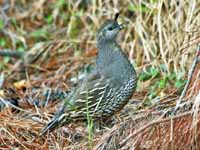


Quail,_Elegant Callipepla douglasii
Description: The male elegant quail has a blue-grey lower-mantle and upper-tail. The upper-mantle is mottled blue-grey and brown. The wing-covers are chestnut with white streaks. He has a golden buff crest plus a grey and white speckled throat. The underparts are grey with white scaling on the belly. The female is similar with a brown crust. The elegant quail is up to 25 cm long.
Range: Northwestern Mexico.
Habitat: Thorny scrub and deciduous forest.
Diet: Mainly seeds, maybe insects.
Conservation status: Least Concern.
Image by: 1) Jorge_Montejo - Sonora, Mexico 2) Francisco_Farriols_SarabiaRange: Northwestern Mexico.
Habitat: Thorny scrub and deciduous forest.
Diet: Mainly seeds, maybe insects.
Conservation status: Least Concern.


Quail,_Gambel's Callipepla gambelii
Description: The Gambel's quail has bluish-grey plumage on much of its body. It does not have white scales on the underparts. The male has copper feathers on top of head, a cinnamon crown, black face, and white stripes above the eyes. He has a grey breast, black in the center of the belly, and chestnut flanks with white strpes. The female is similar to the male. She has a smaller crest, plain grey rest of the head, and the belly lacks the black patch. The Gambel's quail is about 25 cm long. It is rarely seen in flight; they rather run from danger. The similar California quail has white scales on the belly.
Range: Southwest USA and western Mexico.
Habitat: Desert regions.
Diet: Seeds, berries, cactus fruit.
Conservation status: Least Concern.
Image by: 1) Alan D Wilson - New Mexico 2, 4) Dick Daniels - Arizona at Desert Botantical Gardens 3) Ted Grussing in ArizonaRange: Southwest USA and western Mexico.
Habitat: Desert regions.
Diet: Seeds, berries, cactus fruit.
Conservation status: Least Concern.
1, 2) Female 3, 4) Male



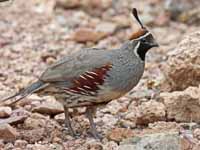
Quail,_Scaled Callipepla squamata
Description: The scaled quail is named for the scaly appearance of its underparts. Along with its scaly markings, the bird is easily identified by its white crest that resembles a tuft of cotton. It makes a grass-lined nest in a depression of the ground. The scaled quail is about 30 cm long.
Range: Soouthwestern USA to central Mexico.
Habitat: Open woodlands, sagebrush, pinyon-juniper, and other dry areas.
Diet: Seeds, insects, leaves.
Conservation status: Least Concern.
Image by: 1) Brian Ungard - New Mexico 2) Ron_Knight - Colorado 3) Gary Kramer USDA - New Mexico 4) Gregory_Smith - NMRange: Soouthwestern USA to central Mexico.
Habitat: Open woodlands, sagebrush, pinyon-juniper, and other dry areas.
Diet: Seeds, insects, leaves.
Conservation status: Least Concern.




Genus Colinus
The bobwhites are so named because they sometimes have calls which sound like "bob white". There are three species: the northern bobwhite is in North America including Mexico; the black-throated around the Yucatan Peninsular, and the crested continues south into northern South America. Especially when not in breeding season, they are social and group together while foraging for food and roosting. These bobwhite groups are referred to as coveys. Bobwhites feed on the ground, scratching like chickens to discover seeds and insects.
Bobwhite, Black-throated also Yucatan Bobwhite Colinus nigrogularis
Description: The male black-throated bobwhite has a reddish-brown mantle and upper-neck with white speckles. The rest of the upperparts are brownish, barred reddish-brown and grey. He has a black crown and eye-line, black throat edged with white, and a white forehead. The underparts have white feathers edged with black which produces a scalloped appearance. The similar female has a black mantle and nape with paler speckles. Her white underparts are barred reddish-brown and black. The black-throated bobwhite is about 20 cm long.
Range: Yucatan Peninsula southwards to Honduras and Nicaragua.
Habitat: Forest clearings, treed grasslands. Also mangroves.
Diet: Seeds.
Conservation status: Least Concern.
Image by: 1) Amy_McAndrews - Yucatan (Mexico) 2) James_BattRange: Yucatan Peninsula southwards to Honduras and Nicaragua.
Habitat: Forest clearings, treed grasslands. Also mangroves.
Diet: Seeds.
Conservation status: Least Concern.


Bobwhite,_Crested Colinus cristatus
Description: The crested bobwhite has brown upperparts with black and grey mottling. The underparts are brown with white spots which are more abundant on the belly. There are about 20 subspecies and the plumage is very variable, especially that of the head. Some have white superciliums that curve downward to meet the neck. The supercilium may by other colors such as rufous or may be nonexistent. There usually is an eye-line that also curves to the neck. There is always a crest but that varies too. The more northern subspecies has a smaller crest. The color of the crest varies from yellow or white to dark. Most build nests in a depression on the ground, but some have the nest slightly elevated. The nest is made of grass. The crested bobwhite averages 20 cm long.
Range: Costa Rica, Panama, northern South America .
Habitat: Grassed areas with some trees.
Diet: Grass seeds, insects, small fruits.
Conservation status: Least Concern.
Image by: 1) Steve_Garvie - Costa Rica 2) Daisyree Bakker - Netherland Antiles 3) Barloventomagico - Venezuela 4) Alejandro_TamayoRange: Costa Rica, Panama, northern South America .
Habitat: Grassed areas with some trees.
Diet: Grass seeds, insects, small fruits.
Conservation status: Least Concern.
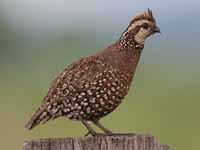



Bobwhite,_Northern Colinus virginianus
Description: The northern bobwhite has more than 20 subspecies, so there is considerable variation in their plumage across their range. The length is from 24 to 28 cm. As is true for most animals, the further north subspecies are larger. The male northern bobwhite has brown upperparts with tan and black barring. He has a dark crown, black eye-line that curves down to meet the nape, and the rest of the head is white. The underparts along their median line are mainly white with black scalloping. Proceeding towards the flanks the white transitions to chestnut. The similar female has a brown crown, buff instead of white on most of the face, and a less distinct eye-line.
Range: USA east of the Rocky Mountains, Caribbean, Mexico.
Habitat: Relatively open areas, usually with some grass.
Diet: Seeds, insects, spiders, snails.
Conservation status: Least Concern.
Image by: 1, 3) Dick Daniels - Sylvan Heights 2) Erin and Lance Willet 4) Brian_Stansberry - TennesseeRange: USA east of the Rocky Mountains, Caribbean, Mexico.
Habitat: Relatively open areas, usually with some grass.
Diet: Seeds, insects, spiders, snails.
Conservation status: Least Concern.
1, 2) Female 3, 4) Male




Genus Cyrtonyx
Quail,_Montezuma Cyrtonyx montezumae
Description: The Montezuma quail has tan upperparts with longitudinal light buff streaks or oblong black spots arranged in bars. The male has a swirling black-and-white face pattern that leads to the species alternate name of the harlequin quail. It has a low tan crest that runs from the rear crown and down the nape. The underparts are black with white dots. The female upperparts are similar to the male's and she has a similar crest. Her face is suggestive of the male's, but not as bold. She has light brown underparts with some black lines. The Montezuma quail is about 22 cm log. They are social and from coveys (groups) that are usually under a dozen. The similar male ocellated quail has less white spotting on the sides. The females are more difficult to tell apart, but their ranges are separated by the broad Isthmus of Tehuantepec.
Range: Mainly Mexico; also southwest USA.
Habitat: Open woods with tallish grass.
Diet: Tubers, acorns, seeds. Insects during breeding.
Conservation status: Least Concern.
Image by: 1) Gregory_Smith 2) Jerry_Oldenettel 3) Dominic_Sherony 4) Dick Daniels - Sylvan HeightsRange: Mainly Mexico; also southwest USA.
Habitat: Open woods with tallish grass.
Diet: Tubers, acorns, seeds. Insects during breeding.
Conservation status: Least Concern.
1) Female 2 - 4)Male




Quail,_Ocellated Cyrtonyx ocellatus
Description: The ocellated quail is similar to the Montezuma quail. The main difference is that the male ocellated quail does not have spotting on its flanks. The ocellated quail range is separated from that of the Montezuma quail by the broad Isthmus of Tehuantepec
Range: Southern Mexico to northern Nicaragua.
Habitat: Pine-oak forest, woodlands with grass.
Diet: Tubers, acorns, seeds, herbs.
Conservation status:It is listed as Vulnerable as the population is declining because of expanding agricultural land.
Image by: 1) John_Van_DortRange: Southern Mexico to northern Nicaragua.
Habitat: Pine-oak forest, woodlands with grass.
Diet: Tubers, acorns, seeds, herbs.
Conservation status:It is listed as Vulnerable as the population is declining because of expanding agricultural land.

Genus Dactylortyx - 1 species
Quail,_Singing Dactylortyx thoracicus
Description: The male singing quail has mottled grey and brown upperparts with thin white streaks. He has a dark brown crown, a buff and black collar, and a tawny orange face with a black streak behind the eye. The breast and upper-belly are greyish brown with white streaks transitioning to white on the lower-belly. The female is similar with a grey face, white throat, and paler brown breast. The singing quail is 20 to 23 cm.
Range: Mexico, Central America.
Habitat: Woods with sparse undergrowth, clearing, plantations.
Diet: Bulbs, seeds, and insects.
Conservation status: Least Concern.
Image by:
1) Amy_McAndrews - Mexico 2) Jerry_Oldenettel - Mexico 3) Nick Athanas - MexicoRange: Mexico, Central America.
Habitat: Woods with sparse undergrowth, clearing, plantations.
Diet: Bulbs, seeds, and insects.
Conservation status: Least Concern.



Genus Dendrortyx
The wood-partridges at 30 to 42 cm are larger than most quails. They are mainly ground dwelling, but some will forage in shrubs for fruits and flowers. The are found in woodlands, but also more open areas such as farm lands. Wood-partridges resemble chickens in their overall shape.
Partridge,_Bearded_Wood- Dendrortyx barbatus
Description: The bearded wood-partridge has buff, brown, and grey upperparts with some red around the nape. It has a bluish-grey head with a light brown small crest. There is a red bill and red around the eyes. It has mainly cinnamon underparts. The male makes a dome-shaped nest with a tunnel entrance. The bearded wood-partridge is 33 to 36 cm long.
Range: Eastern Mexico.
Habitat: Humid montane woodlands, farmland.
Diet: Seeds, fruits, buds, tubers, and insects. Forages on the ground.
Conservation status: It is listed as Vulnerable because it has a fragment range with a small population.
Image by: 1) Alberto_LobatoRange: Eastern Mexico.
Habitat: Humid montane woodlands, farmland.
Diet: Seeds, fruits, buds, tubers, and insects. Forages on the ground.
Conservation status: It is listed as Vulnerable because it has a fragment range with a small population.
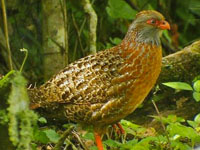
Partridge, Buffy-crowned Wood- Dendrortyx leucophrys
Description: The buffy-crowned wood-partridge has a chicken-like appearance due to its long tail and legs. It has chestnut and grey upperparts including the tail. The face and forehead are pale buff and there is red around the eyes. The underparts are blue-grey with chestnut streaks. It builds a domed nest out of grasses. The buffy-crowned wood-partridge is up to 35 cm long.
Range: Southern Mexico, Central America.
Habitat: Humid montane woodlands, coffee plantations.
Diet: Seeds, buds, small fruits, and invertebrates. Forages on the ground like a chicken.
Conservation status: Least Concern.
Image by: 1) Immelbatoast 2) Grete_PaschRange: Southern Mexico, Central America.
Habitat: Humid montane woodlands, coffee plantations.
Diet: Seeds, buds, small fruits, and invertebrates. Forages on the ground like a chicken.
Conservation status: Least Concern.


Partridge, Long-tailed Wood- Dendrortyx macroura
Description: The long-tailed wood-partridge has a chestnut mantle which is edged with grey, The lower back is mottled black, brown and tawny. It has a long black tail. The head is black with white above the eye and another below. It has a black crest. The underparts are bluish-grey with chestnut streaks. The long-tailed wood-partridge is 30 to 42 cm long.
Range: Southern Mexico.
Habitat: Montane woodlands with plentiful shrubs.
Diet: Seeds, fruits, herbs, flowers. Forages on the ground and also on bushes.
Conservation status: Least Concern.
Image by: 1) Biodiversity_Heritage_Library 2) Nick Athanas - Mexico 3) EusebioRange: Southern Mexico.
Habitat: Montane woodlands with plentiful shrubs.
Diet: Seeds, fruits, herbs, flowers. Forages on the ground and also on bushes.
Conservation status: Least Concern.


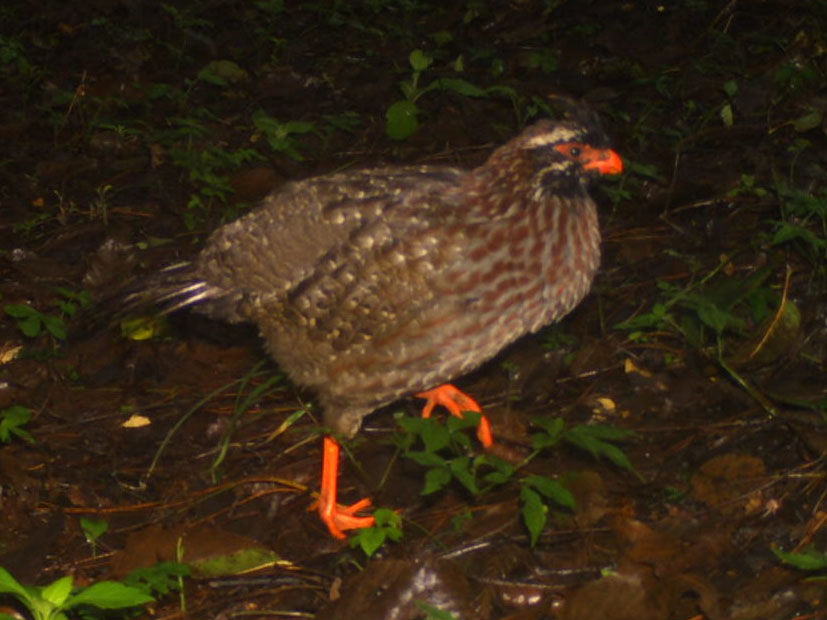
Genus Odontophorus
The wood-quails are difficult to observe even by expert birders, so detailed information about diet and nesting behaviour is not available for many of the species. The best time to see them is at dawn or dusk when they are busy feeding. They seem to mostly forage on the ground for seeds, insects, and fruits, The wood-quails usually roost in trees or bushes. When threatened they will run, only flying as a last resort.
They are found in tropical and subtropical forests which could be either virgin or second growth with thick undergrowth. The various species are mostly found in Central America and northern South America.
Quail,_Black-breasted Wood- Odontophorus leucolaemus
Description: The black-breasted wood-quail has dark brown upperparts. It has a black head and a white throat of variable size. The breast is mainly black but there is substantial amount of brown on some birds. The bill is usually black. The black-breasted wood-quail is 22 to 25 cm long.
Range: Mainly Costa Rica; also Panama.
Habitat: Woodlands.
Diet: May take plant matter, supplemented with insects".
Conservation status: Least Concern.
Image by: 1) John_Gerrard_Keulemans 2) David_Rodríguez_Arias - Costa RicaRange: Mainly Costa Rica; also Panama.
Habitat: Woodlands.
Diet: May take plant matter, supplemented with insects".
Conservation status: Least Concern.


Quail,_Black-eared_Wood- Odontophorus melanotis
Description: The black-eared wood-quail has black upperparts with grey edgings. It has a chestnut crown and crest.
The face, bill, and throat are black. It has a rufous breast becoming light brown on the belly. The black-eared wood-quail is up to 28 cm long.
Range: Costa Rica, Honduras, Nicaragua, and Panama.
Habitat: Woodlands, especially with thick undergrowth.
Diet: Insects and fruits which it forages for on the ground.
Conservation status: Least Concern.
Image by: 1) John_Gerrard_Keulemans 2) Mikael_BauerRange: Costa Rica, Honduras, Nicaragua, and Panama.
Habitat: Woodlands, especially with thick undergrowth.
Diet: Insects and fruits which it forages for on the ground.
Conservation status: Least Concern.


Quail,_Black-fronted_Wood- Odontophorus atrifrons
Description: The black-fronted wood-quail has mainly grey-brown plumage. It has a black forehead, face, and throat. There is a dark rufous crest. The black-fronted wood-quail is 24 to 30 cm long. There is no range overlap with other Odontophorus.
Range: Columbia, Venezuela.
Habitat: Montane tropical and subtropical forests.
Diet: Insects and berries that it finds on the ground.
Conservation status: It is listed as Vulnerable because it is only found in a small range and the habitat is degrading.
Image by: 1) Bryant_Olsen 2) Nick Athanas - Columbia 3) Sanzbirder - ColumbiaRange: Columbia, Venezuela.
Habitat: Montane tropical and subtropical forests.
Diet: Insects and berries that it finds on the ground.
Conservation status: It is listed as Vulnerable because it is only found in a small range and the habitat is degrading.



Quail,_Chestnut Wood- Odontophorus hyperythrus
Description: The chestnut wood-quail has brown upperparts with small white spots. It has a chestnut head and underparts. It has greyish white around the eyes, with that being more pronounced for the female. She has a grey belly instead of chestnut. The chestnut wood-quail is 25 to 29 cm long. Nests are domed globes on the ground made of leaves and twigs with a short tunnel entrance.
Range: Columbia.
Habitat: Interior and edges of montane woodlands.
Diet: Seeds, berries, and maybe insects. It forages on the ground.
Conservation status: Least Concern.
Image by: 1) Francesco_VeronesiRange: Columbia.
Habitat: Interior and edges of montane woodlands.
Diet: Seeds, berries, and maybe insects. It forages on the ground.
Conservation status: Least Concern.
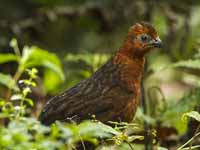
Quail,_Dark-backed Wood- Odontophorus melanonotus
Description: The dark-backed wood-quail has dark brown upperparts. It has a blackish head and bill. The throat and breast are rufous-chestnut. The belly is blackish with chestnut vermiculation.
Range: Ecuador and the adjacent area of Columbia.
Habitat: Tropical woodlands, mainly between 1000 and 2000 meters.
Diet: Probably fruits, berries, and insects.
Conservation status: It is listed as Vulnerable because of a small range, decreasing habitat, and it is seldom seen.
Image by: 1) Francesco_Veronesi 2) Jerry_Oldenettel - Ecuador 3) PE_Hart - EcuadorRange: Ecuador and the adjacent area of Columbia.
Habitat: Tropical woodlands, mainly between 1000 and 2000 meters.
Diet: Probably fruits, berries, and insects.
Conservation status: It is listed as Vulnerable because of a small range, decreasing habitat, and it is seldom seen.



Quail,_Gorgeted Wood- Odontophorus strophium
Description: The gorgeted wood-quail has brown upperparts. It has a short blackish-brown crest, black-and-white face, black throat, white collar, and rufous-brown underparts.
Range: Columbia.
Habitat: Temperate and subtropical forests of oak and laurel trees.
Diet: Fruits, seeds, insects and other arthropods.
Conservation status: It is listed as Vulnerable because of its small range and declining population.
Image by: 1) John_GouldRange: Columbia.
Habitat: Temperate and subtropical forests of oak and laurel trees.
Diet: Fruits, seeds, insects and other arthropods.
Conservation status: It is listed as Vulnerable because of its small range and declining population.

Quail,_Marbled_Wood- Odontophorus gujanensis
Description: The marbled wood-quail has a greyish-brown mantle and neck. The rest of the back and wings are brown with black vermiculation. It has a dark brown crest and orange-red orbital skin. The underparts are buff or brownish and finely barred. When disturbed it will run away on foot, but fly if necessary. The marbled wood-quail is up to 29 cm long. The similar spot-winged wood-quail has greyer underparts than the marbled Wood-quail.
Range: Costa Rica, Panama, northern South America.
Habitat: Undergrowth of rainforests and cloud forests.
Diet: Seeds, fruits, insects, spiders, worms.
Conservation status: Least Concern.
Image by: 1) Smithsonian Wild - Peru 2) Francesco_Veronesi - Costa Rica 3) Ken_Rosenberg, PanamaRange: Costa Rica, Panama, northern South America.
Habitat: Undergrowth of rainforests and cloud forests.
Diet: Seeds, fruits, insects, spiders, worms.
Conservation status: Least Concern.



Quail,_Rufous-fronted_Wood- Odontophorus erythrops
Description: The rufous-fronted wood-quail has dark mottled upperparts. Most of the head is rufous with a black narrow crest and black nape stripe. It has a black throat and some subspecies have a white throat. The breast is rufous and the belly darker rufous. The rufous-fronted wood-quail is 23 to 28 cm long.
Range: The Pacific slope of the Andes in Columbia and Ecuador.
Habitat: Humid tropical forests.
Diet: Little data.
Conservation status: Least Concern.
Image by: 1) Dale_Toweill - Ecuador 2) Nick Athanas - EcuadorRange: The Pacific slope of the Andes in Columbia and Ecuador.
Habitat: Humid tropical forests.
Diet: Little data.
Conservation status: Least Concern.
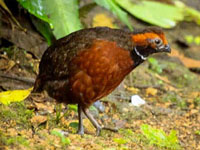

Quail,_Rufous-breasted_Wood- Odontophorus speciosus
Description: The rufous-breasted wood-quail has brown upperparts with black vermiculation and a little white. The crown and nape are dark brown. There is a wide white supercilium that continues towards the nape and another white malar streak. These white stripes can be bold, faint, or missing. The throat is black and the breast is rufous with the belly dark. The rufous-breasted wood-quail is up to 28 cm long.
Range: Mainly on the east side of the Andes in Bolivia, Ecuador, and Peru.
Habitat: Moist montane forests.
Diet: Unknown but probably includes seeds and insects.
Conservation status: It is listed as Near Threatened because of little data. The population might actually be stable.
Image by: 1) Carlos_Calle in PeruRange: Mainly on the east side of the Andes in Bolivia, Ecuador, and Peru.
Habitat: Moist montane forests.
Diet: Unknown but probably includes seeds and insects.
Conservation status: It is listed as Near Threatened because of little data. The population might actually be stable.

Quail,_Spot-winged Wood- Odontophorus capueira
Description: The spot-winged wood-quail has greyish-brown upperparts with dark vermiculations. The wing coverts have small white spots. It has a reddish brown crest and reddish superciliums and eye-rings. The face, throat, and underparts are slate-grey. It has a grey bill. The spot-winged wood-quail is up to 30 cm long.
Range: Mainly eastern Brazil. Also Argentina, Paraguay.
Habitat: Dry lowland forests.
Diet: Nuts, berries, and probably insects.
Conservation status: Least Concern.
Image by: 1, 2, 3) Dario Sanches - São Paulo, Brazil 4) Brendan_Ryan - BrazilRange: Mainly eastern Brazil. Also Argentina, Paraguay.
Habitat: Dry lowland forests.
Diet: Nuts, berries, and probably insects.
Conservation status: Least Concern.



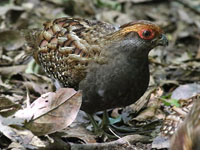
Quail,_Spotted Wood- Odontophorus guttatus
The spotted wood-quail has dark brown upperparts with black and rufous flecking, It has an orange crest (female has blackish crest), red on the sides of the crest, black face, black bill, and a black throat. The underparts are brown or red depending on the morph. In either case the underparts has many small white spots. The spotted wood-quail averages about 25 cm long.
Range: Southern Mexico to Panama.
Habitat: Woodlands with dense undergrowth.
Diet: Seeds, fruits, insects. They forage on the ground.
Conservation status: Least Concern.
Image by: 1) Gatobarato - Costa Rica 2) Hans_Norelius - Costa Rica 3) John_Whitaker - Costa Rica 4) Barbara_Dye - Costa Rica Range: Southern Mexico to Panama.
Habitat: Woodlands with dense undergrowth.
Diet: Seeds, fruits, insects. They forage on the ground.
Conservation status: Least Concern.




Quail,_Starred_Wood- Odontophorus stellatus
Description: The starred wood-quail has mainly olive-brown upperparts with darker vermiculations. The mantle and neck are grey. Males have a reddish-brown crest and females brownish-black. The fore-crown is dark brown and there is a yellow eye-ring; the rest of the head is grey. It has reddish-brown underparts with some inconspicuous white speckles on the breast leading to its starred name. Coveys of less than 10 birds are formed. The starred wood-quail is 24 to 28 cm long.
Range: Ecuador, Peru, northern Bolivia and adjacent Brazil.
Habitat: Lowland forests; usually below 1000 meters.
Diet: Insects, berries.
Conservation status: Least Concern.
Image by: 1) John_Gould 2) Roger WasleyRange: Ecuador, Peru, northern Bolivia and adjacent Brazil.
Habitat: Lowland forests; usually below 1000 meters.
Diet: Insects, berries.
Conservation status: Least Concern.


Quail,_Stripe-faced Wood- Odontophorus balliviani
Description: The stripe-faced wood-quail has brown upperparts with black spots. The lower-back has fewer black spots. It has a chestnut crown and crest with a buff border. The face is buff with a thick black eye-line and a black bill. It has light brown underparts covered with small white diamond shapes. The stripe-faced wood-quail is 26 to 28 cm long.
Range: In the Yungas of Bolivia and Peru .
Habitat: Woodlands, clearings, wet meadows.
Diet: Not available; probably seeds and insects.
Conservation status: Least Concern.
Image by: 1) thibaudaronsonRange: In the Yungas of Bolivia and Peru .
Habitat: Woodlands, clearings, wet meadows.
Diet: Not available; probably seeds and insects.
Conservation status: Least Concern.

Quail,_Tacarcuna Wood- Odontophorus dialeucos
Description: The male Tacarcuna wood-quail has olive-brown upperparts with black vermiculations. He has a black crown, white face, and black throat. It has a cinnamon nape. His underparts are chestnut with some white dots. The similar female has lighter underparts
Range: Columbia, Panama.
Habitat: Tacarcuna Ridge in subtropical forests between 1000 and 1500 meters.
Diet: Not available; probably seeds and insects.
Conservation status: Least Concern.
Range: Columbia, Panama.
Habitat: Tacarcuna Ridge in subtropical forests between 1000 and 1500 meters.
Diet: Not available; probably seeds and insects.
Conservation status: Least Concern.
Quail,_Venezuelan_Wood- Odontophorus columbianus
Description: The Venezuelan wood-quail hs vermiculated reddish-brown upperparts with black spots The male has a white throat, while the female's throat has just a little white. The underparts are rufous with white spots. The Venezuelan wood-quail is 25 to 30 cm long.
Range: Venezuela.
Habitat: Subtropical cloud forest.
Diet: Seeds, fruits, insects, worms.
Conservation status: It is listed as Near Threatened because of its small range and possible population decline.
Image by: 1) Jerry_Oldenettel 2) David_Ascanio 3) Peter_BoesmanRange: Venezuela.
Habitat: Subtropical cloud forest.
Diet: Seeds, fruits, insects, worms.
Conservation status: It is listed as Near Threatened because of its small range and possible population decline.



Genus Oreortyx - 1 species
Quail,_Mountain Oreortyx pictus
Description: The mountain quail have brown upperparts. It has a mostly grey head, grey crest, black head plume, and a brown face with a white border. The breast is grey and the belly chestnut with bold white stripes on the sides. The mountain quail is 26 to 28 cm long. The similar California quail has a curved tuft on top of its head,
Range: West of the Rocky Mountains from British Columbia to Baja Peninsular of Mexico.
Habitat: Scrublands, open woodlands
Diet: Seeds, fruit; also flowers and insects.
Conservation status: Least Concern.
Image by: 1, 2) George Lamson - Donner, California 3) USFWS 4) Aaron_Maizlish - CalifroniaRange: West of the Rocky Mountains from British Columbia to Baja Peninsular of Mexico.
Habitat: Scrublands, open woodlands
Diet: Seeds, fruit; also flowers and insects.
Conservation status: Least Concern.

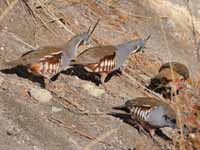


Genus Philortyx - 1 species
Quail,_Banded Philortyx fasciatus
Description: The banded quail has light brown upperparts with some black squares. It has a dark crest. The underparts are heavily barred black-and-white barred. The banded quail is 21 cm long.
Range: Southern Mexico.
Habitat: Dry scrubland, pasture.
Diet: Seeds, insects, tubers, buds.
Conservation status: Least Concern.
Image by: 1) Amy_McAndrews 2) Jesper_Bay_JacobsenRange: Southern Mexico.
Habitat: Dry scrubland, pasture.
Diet: Seeds, insects, tubers, buds.
Conservation status: Least Concern.

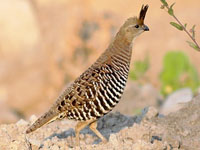
Genus Rhynchortyx - 1 species
Quail,_Tawny-faced Rhynchortyx cinctus
Description: The male tawny-faced quail has ra ufous face, dark eye-line, grey breast, and a buff belly. The female has a white post-eye stripe, brown head, brown breast, and dark scaling over flanks plus the belly. The tawny-faced quail is 17 to 20 cm long.
Range: Central America, Columbia, northwest Ecuador
Habitat: Tropical forests.
Diet: Seeds, worms, insects.
Conservation status: Least Concern.
Image by: 1) Diego_Calderon 2) John_Gerrard_Keulemans Range: Central America, Columbia, northwest Ecuador
Habitat: Tropical forests.
Diet: Seeds, worms, insects.
Conservation status: Least Concern.
1) Male
